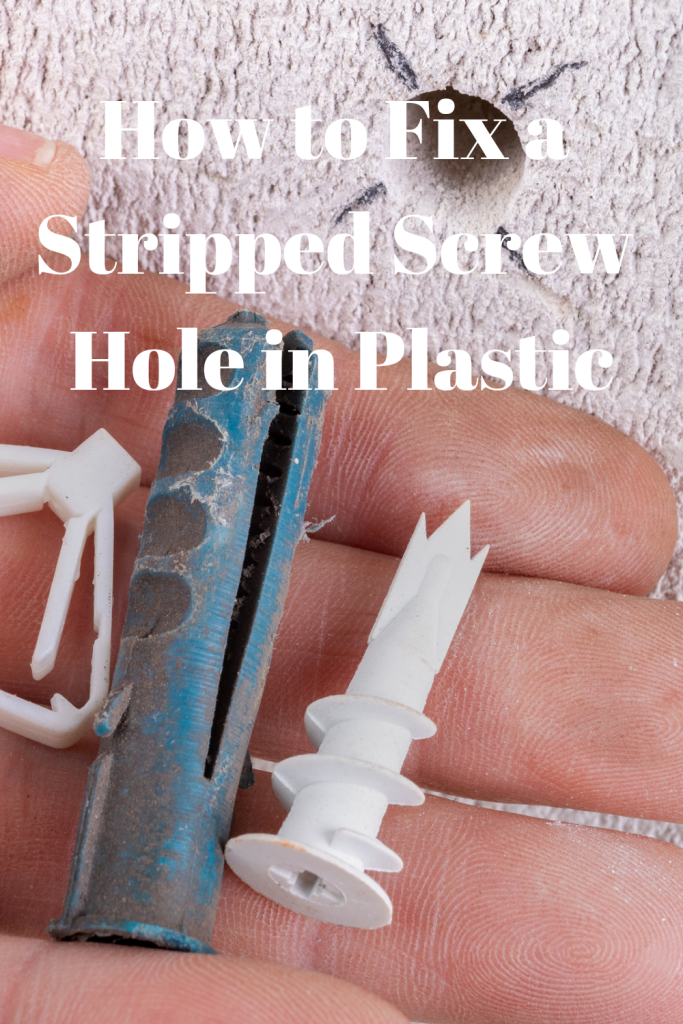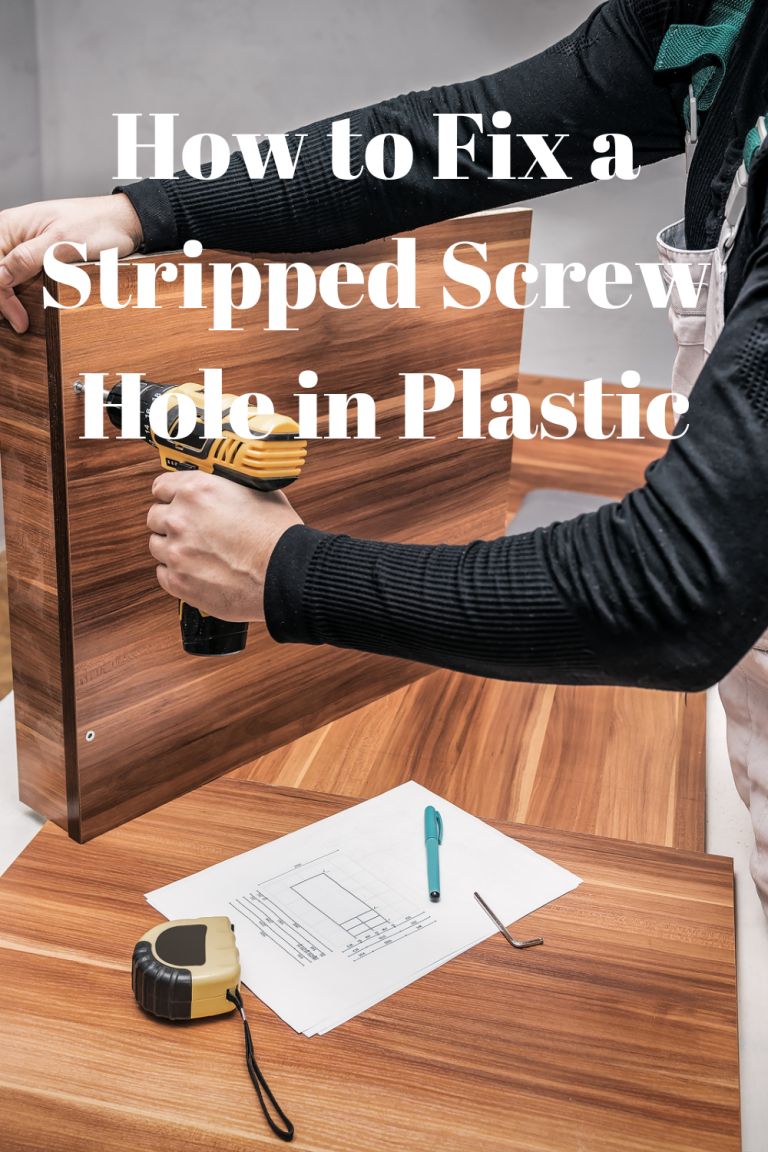
How to Fix a Stripped Screw Hole in Plastic
Woodworkers often turn to Cyanoacrylate glue (superglue) when working on stripped screw holes, while others opt for toothpicks, wooden dowels and chopsticks dipped in wood glue for quick fixes.
Plastic anchors and glue can also be found in kits designed to repair screws. These plug-like anchors hold screws securely into place when being driven back in.
1. Assess the Damage
Stripped screw holes in plastic products can be quite irritating, even preventing you from using certain items altogether. Luckily, there are ways around this problem and you don’t have to buy new replacements just yet!

One common solution involves jamming something wooden into a screw hole to form new threads for it to bite into, such as toothpicks, chopsticks, golf tees or pieces of wood scraps. However, using inappropriate materials may render this method ineffective as they should grip onto and grip around the screw rather than simply fill in its hole.
Fixing a stripped screw hole in plastic quickly and efficiently is simple with epoxy or strong glue – an ideal option is cyanoacrylate glue which quickly bonds. Simply apply some small amount to the hole, allow it to set, and reinsert your screw.
Screws may become stripped for various reasons, including excessive stress or wear-and-tear. This problem often appears in areas that experience regular movement such as hinges on door frames or chests; additionally, this issue often appears in workshops or home offices that allow direct access to screwed joints.
Screws may become stripped when used incorrectly in terms of size or thread pitch. To prevent this from occurring, make sure you choose an appropriate screw for each task; larger screws have more robust threads that will provide better plastic grip while coarser pitch screws may help cut into fresh threads instead of boring into existing ones.
2. Remove the Screw
When dealing with a stripped screw hole in plastic, removing it may prove challenging. Doing this may necessitate using tools such as hammers and grinders; however, there may also be alternative strategies available that could potentially ease this task. Here are a few effective solutions that could be tried instead:
One way is to choose a larger diameter or longer length screw. This should help the new screw grip the entire hole better and be less likely to strip; however, make sure that it still fits tightly or it could split your mount.

An alternative option for extracting stripped screws is using a stripped screw extractor, an attachment for your drill that helps you extract them. These tools can be purchased online or from local hardware stores. However, these may not always be necessary and can become quite pricey over time.
If a screw hasn’t become completely stripped, try using locking pliers as an aid in unscrewing it. They provide extra grip while making removal more manageable – you may also be able to twist or turn outward without stripping its threads completely!
As another option, try using a left-handed drill bit. These lesser-used bits feature flutes that turn in an anticlockwise direction for improved screw loosening in stripped holes. While it won’t always work perfectly, left-handed bits may provide temporary relief.
3. Fill the Hole
One effective solution for fixing stripped screw holes is using a different kind of screw. A wider diameter or longer-in-length version can often grab more securely into its target hole than smaller screws can, making the whole assembly much more reliable than before. But be careful in selecting an appropriate size: using too large of an option could split plastic mounts, leaving both item useless and screw permanently damaged.
Another straightforward option for filling holes quickly and cheaply is using glue such as wood glue or automotive epoxy to fill them in quickly and cheaply, suitable for any kind of screw (self-tapping or not). Although driving screws back into these holes could strip their threads back out again if driven too hard, the alternative might not work as effectively.
If you don’t have wood glue or automotive epoxy on hand, try using a toothpick or matchstick to pack a stripped screw hole instead. Their wide body helps fill any cracks around it while gripping it for driving purposes.
Use a plastic welder to plug up holes. This specialized tool utilizes heat to melt and fuse plastic materials together, but it’s also a fantastic solution for one-off repairs or small projects.

To use a plastic welder, first clean and clear away any debris in the area you wish to weld in. Next, cut or obtain a piece of plastic that fits the hole you wish to fill; place it in the welder; heat both ends until they melt; push in screw; let cool before pushing screw back out again.
4. Reinforce the Repair
There are various approaches available to fix a stripped screw hole, ranging from using cyanoacrylate glue and other superglues to thread inserts and tap-and-die kits. You should select the method which best meets your situation and budget.
Woodworkers often opt for replacing stripped screw holes with longer, wider or coarser screws to ensure the new screw bites into fresh wood and does not strip out old holes. Just be wary not to choose one so large it splits the wood or incompatible with hinges or brackets.
Similar procedures apply when fixing stripped screw holes in metal. On sheet metal, this may mean drilling out and filling out the hole with nuts or bolts to provide an even surface for future screws; alternatively, moving the screws may suffice in some instances.
Plastic wall anchors may also help repair stripped screw holes in plastic, and can be found easily at shops and markets. These anchors act like plugs to grip surfaces for screws before being glued in place – providing extra reinforcement of damaged plastic while helping fix stripped holes in plastic.
Auto body filler is a type of super glue commonly used to repair small dents and dings on vehicles. If you have some of this filler on hand, mix in sawdust or another fine material for extra strength – but always wear gloves when handling it as too much pressure may crack or break your plastic surface!
5. Drive the Screw Back in
Fixing stripped screw holes in plastic can be done through several means. One such method is using a repair kit, available online and at woodworking stores. These kits contain small plastic anchors which are glued inside each hole to provide gripping surfaces for screw threads when you redrive them – an effective, yet more expensive, option than DIY fixes.
One alternative solution is wood glue, available at most hardware stores and both solid and liquid forms. Simply place a drop of wood glue on the tip of a screwdriver and apply it directly onto the head of the screw. This will prevent its possible movement or extraction from its hole.
Rather than reaching for wood glue, try toothpicks or wooden Q-tips as temporary fixes instead. Electronic technicians and carpenters commonly employ this strategy when holding screws in place – it provides quick fixes but will only last temporarily.
Finally, another approach would be to drill out and re-drill the screw. While this may take more time and patience than other methods, it often works. Just ensure to use a high-quality drill bit so as not to damage plastic or the hole itself; wear safety goggles while drilling in order to protect your eyes from glue debris; once all this has dried you can redrive the screw into its spot but be mindful not overtighten as that could strip threads again!
